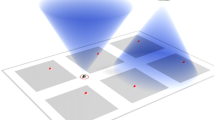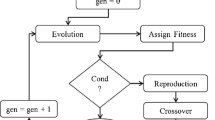Abstract
This paper focuses on various coevolutionary robotic experiments where all parameters except for the fitness function remain the same. Initially an attempt to categorize coevolutionary experiments is made and subsequently three experiments of competitive coevolution (hunt, battle and mating) are presented. The experiment concerning implicit competition of two species (mating) is given special attention as it shows emergence of compromise and collaboration through a competitive environment. The co-evolution progress monitoring is evaluated through fitness graphs, CIAO and Hamming maps and the results are interpreted for each experimental setup. The paper concludes that despite the alteration of fitness functions, several evasion–pursuit elements emerge. Furthermore, conciliatory strategies can emerge in implicit competitional cases.
Similar content being viewed by others
References
Arkin, R.C.: Navigational path planning for a vision-based mobile robot. Robotica 7, 49–63 (1989)
Blair, A.D., Pollack, J.: What makes a good co-evolutionary learning environment? Aust. J. Intell. Inf. Process. Syst. 4(3/4), 166–175 (1997)
Brooks, R.A.: Cambrian Intelligence. MIT Press, Cambridge, MA (1999)
Buason, G., Ziemke, T.: Explorations of task-dependent visual morphologies in competitive co-evolutionary experiments. In: Banzhaf, W. et al. (eds.) Advances in Artificial Life — The 7th European Conference on Artificial Life, pp. 763–770. Springer, Berlin, Heidelberg, New York (2003)
Carlsson, J., Ziemke, T.: YAKS — Yet Another Khepera Simulator. In: Rückert, Sitte, Witkowski (eds.) Autonomous Minirobots for Research and Entertainment, pp. 235–241. HNI-Verlagsschriftenreihe, Paderborn, Germany (2001)
Cliff, Miller: Co-evolution of pursuit and evasion I: Biological and Game-theoretical foundations, Technical Report CSRP311, University of Sussex, School of Cognitive and Computing Science (1995a)
Cliff, Miller: Tracking the red Queen: Measurements of adaptive progress in co-evolutionary simulations. In: Moran, F., Moreno, A., Merelo, J.J., Chacon, P. (eds.) Advances in Artificial Life, pp. 200–218 (1995b)
Cliff, Miller: Co-evolution of pursuit and evasion II: Simulation methods and results. In: From Animals to Animats 4: Proceedings of the Fourth International Conference on Simulation of Adaptive Behavior, pp. 506–514. MIT Press, Cambridge, USA (1995c)
Ficici, S.G., Pollack, J.B.: A game-theoretic approach to the simple coevolutionary algorithm. In: Schoenauer, et al. (eds.) Parallel Problem Solving from Nature VI, pp. 467–476. Springer (2000)
Floreano, D., Nolfi, S.: God save the red Queen: Competition in evolutionary robotics. In: Koza, J. et al. (eds.) 2nd Conference on Genetic Programming, pp. 398–406. Morgan Kaufmann, San Mateo, CA (1997)
Floreano, D., Nolfi, S., Mondada, F.: Co-evolution and ontogenetic change in competing robots. In: Patel, M., Honavar, V., Balakrishnan, K. (eds.) Advances in the Evolutionary Synthesis of Intelligent Agents, pp. 273–306. MIT Press, Cambridge, MA (2001)
Harvey, P. Husbands, D., Cliff, A., Thompson, N., Jakobi: Evolutionary Robotics: The Sussex approach, Robotics and Autonomous Systems 20 (2–4), pp. 205–224 (1997)
Haynes, T., Sen, S.: Evolving behavioral strategies in predators and prey. In: Weiß, G., Sen, S. (eds.) Adaptation and Learning in Multiagent Systems, pp. 113–126. Springer, Berlin, Heidelberg, New York (1996)
Jakobi, N., Husbands, P., Harvey, I.: Noise and the reality gap: The use of simulation in evolutionary robotics. In: Moran, F., Moreno, A., Merelo, J., Chacon, P. (eds.) Advances in Artificial Life: Proc. 3rd European Conference on Artificial Life, pp. 704–720. Springer, Lecture Notes in Artificial Intelligence 929 (1995)
Kaelbling, L.P., Littman, L.M., Moore, A.W.: Reinforcement learning: a survey. J. Artif. Intell. Res. 4, 237–285 (1996)
Keymeulen, K., Konaka, M., Iwata, Y., Kuniyoshi, Higuchi, T.: “Robot Learning Using Gate–level Evolvable Hardware” Proc. of Sixth European Workshop on Learning Robots (EWLR-6), pp. 173–188. Springer (1998)
K–Team, S.A.: Khepera: User Manual. Switzerland http://ftp.k-team.com/khepera/documentation/KheperaUserManual.pdf (1995)
Michel, O., Clergue, M., Collard, P.: Artificial neurogenesis: applications to the cart-pole problem and to an autonomous mobile robot. Int. J. Artif. Intell. Tools 6(4), 613–634 (1997)
Miglino, O., Lund, H.H., Nolfi, S.: Evolving mobile robots in simulated and real environments. Artif. Life 2, 417–434 (1996)
Nelson, A.L., Grant, E., Henderson, T.C.: Evolution of neural controllers for competitive game playing with teams of mobile robots. Robot. Auton. Syst. 46, 135–150 (2004)
Nolfi, S., Floreano, D.: Co-evolving predator and prey robots: Do ‘arm races’ arise in artificial evolution? Artif. Life 4(4), 311–335 (1998)
Nolfi, S., Floreano, D.: Evolutionary Robotics. MIT Press, Cambridge, MA (2000)
Ostergard, E.H., Lund, H.: Co-evolving Complex Robot Behavior, Proceedings of ICES2003 Trondheim, Norway, pp. 308–319 (2003)
Potter, M., Meeden, L.A., Schultz, A.: Heterogeneity in the coevolved behaviors of mobile robots: The emergence of specialists, Proceedings of the Seventeenth International Joint Conference on Artificial Intelligence, pp. 1337–1343. Morgan Kaufmann (2001)
Quinn, M.: Evolving communication without dedicated communication channels. In: Kelemen, J., Sosνk, P. (eds.) ECAL01, pp. 357–366. Springer, Prague (2001a)
Quinn, M.: A comparison of approaches to the evolution of homogeneous multi-robot teams. In Proceedings of the 2001 Congress on Evolutionary Computation, pp. 128–135 (2001b)
Rosin, C., Belew, R.: New methods for competitive co-evolution. Evol. Comput. 5(1), 1–29 (1996)
Schultz, A.C., Grefenstette, J.J., Adams, W.L.: RoboShepherd: Learning a Complex Behavior. Proc. of the Robots and Learning Workshop (RoboLearn ’96), May 1996, Key West, Florida, pp 105–113. NCARAI Report AIC-96-030 (1996)
Sims, K.: Evolving Virtual Creatures, Computer Graphics (Siggraph ’94 Proceedings), July 1994, pp. 15–22 (1994a)
Sims, K.: Evolving 3D Morphology and Behavior by Competition, Artificial Life IV Proceedings, ed. by Brooks & Maes, 1994, pp. 28–39. MIT Press (1994b)
Stanley, K.O., Miikkulainen, R.: Competitive coevolution through evolutionary complexification. J. Artif. Intell. Res. 21, 63–100 (2004)
Togelius, J.: Evolution of a subsumption architecture neurocontroller. J. Intell. Fuzzy Syst. 15, 15–20 (2004)
Torresenk, J.: Possibilities and Limitations of Applying Evolvable Haxdwaxe to Real-World Applications, Proc. of the 10th Int. Conf on FieM Programmable Logic and Applications, Villach, Austria, pp. 230–239 (2000)
Trianni, V.: Evolution of coordinated motion behaviors in a group of self-assembled robots. Technical Report TR/IRIDIA/2003-25, IRIDIA — Universite Libre de Bruxelles, Belgium, May 2003. DEA Thesis
Watson, R.A., Pollack, J.B. (2001). Coevolutionary Dynamics in a Minimal Substrate. In: Spector, L. et al (eds.) Proceedings of the 2001 Genetic and Evolutionary Computation Conference, pp. 702–709. Morgan Kaufmann, (2001)
Wolff, K., Nordin, P.: An Evolutionary Based Approach for Control Programming of Humanoids. In Proceedings of the 3rd International Conference on Humanoid Robots (Humanoids’03), Karlsruhe, Germany, 2003. VDI/VDE–GMA (2003)
Yamauchi, B.M., Beer, R.D.: Integrating reactive, sequential, and learning behavior using dynamical neural networks. In: Cliff, D., Husbands, P., Meyer, J.-A., Wilson, S.W. (eds.) From Animals to Animats III: Proceedings of the 3rd International Conference on Simulation of Adaptive Behavior, pp. 382–391. MIT Press (1994)
Yao, X., Higuchi, T.: Promises and Challenges of Evolvable Hardware. In Proceedings of First International Conference on Evolvable Systems: from Biology to Hardware, pp. 87–97. Berlin, Heidelberg, New York, Springer (1996)
Author information
Authors and Affiliations
Corresponding author
Rights and permissions
About this article
Cite this article
Mermigkis, I., Petrou, L. Exploring Coevolutionary Relations by Alterations in Fitness Function: Experiments with Simulated Robots. J Intell Robot Syst 47, 257–284 (2006). https://doi.org/10.1007/s10846-006-9083-z
Received:
Accepted:
Published:
Issue Date:
DOI: https://doi.org/10.1007/s10846-006-9083-z




